Degradation Resistance of Next-Generation Dental Composites Under Bleaching and Immersion: A Multiscale Investigation
Abstract
1. Introduction
2. Materials and Methods
2.1. Sample Size Calculations
2.2. Specimen Preparation
2.3. Staining Process
2.4. Bleaching Procedure
2.5. Microhardness Analysis
2.6. Surface Roughness Analysis
2.7. Spectrophotometry Analysis
2.8. Scanning Electron Microscopy (SEM) Analysis
2.9. Statistical Analysis
3. Results
3.1. Vicker’s Microhardness
3.2. Surface Roughness
3.3. Spectrophotometry
3.4. Scanning Electron Microscopy (SEM) Analysis
4. Discussion
5. Conclusions
6. Future Recommendations
Author Contributions
Funding
Institutional Review Board Statement
Data Availability Statement
Acknowledgments
Conflicts of Interest
Abbreviations
| ROS | Reactive oxygen species |
| RW | Red wine |
| D/W | Distilled water |
| SD | Standard deviation |
| VHN | Vickers microhardness |
| SEM | Scanning electron microscopy |
References
- Antonucci, J.M.; Dickens, S.H.; Fowler, B.O.; Xu, H.H.; McDonough, W.G. Chemistry of silanes: Interfaces in dental polymers and composites. J. Res. Natl. Inst. Stand. Technol. 2005, 110, 541. [Google Scholar] [CrossRef] [PubMed]
- Ferracane, J.L. Resin composite—State of the art. Dent. Mater. 2011, 27, 29–38. [Google Scholar] [CrossRef] [PubMed]
- Ilie, N.; Hickel, R. Resin composite restorative materials. Aust. Dent. J. 2011, 56, 59–66. [Google Scholar] [CrossRef]
- Khvostenko, D.; Hilton, T.; Ferracane, J.; Mitchell, J.; Kruzic, J. Bioactive glass fillers reduce bacterial penetration into marginal gaps for composite restorations. Dent. Mater. 2016, 32, 73–81. [Google Scholar] [CrossRef]
- Althaqafi, K.A.; Satterthwaite, J.; Silikas, N. A review and current state of autonomic self-healing microcapsules-based dental resin composites. Dent. Mater. 2020, 36, 329–342. [Google Scholar] [CrossRef]
- Size, P.M. Share & Trends Analysis Report by Product (PE, PP, PU, PVC, PET, Polystyrene, ABS, PBT, PPO, Epoxy Polymers, LCP, PC, Polyamide). Appl. End Use Segm. Forecast. 2022, 2030, 31. [Google Scholar]
- Celik, C.; Yüzügüllü, B.; Erkut, S.; Yazici, A.R. Effect of bleaching on staining susceptibility of resin composite restorative materials. J. Esthet. Restor. Dent. 2009, 21, 407–414. [Google Scholar] [CrossRef]
- PILLAY, S.R.; SUGUMARAN, S.; VARGHESE, R. Preference And Frequency Of Commonly Performed Bleaching Techniques. Int. J. Pharm. Res. 09752366 2020, 17, 2125. [Google Scholar] [CrossRef]
- Dal Picolo, M.Z. Uso de LED Voleta Associado ao Peróxido de Hidrogênio 35% No Clareamento Dental: Relato de Caso. [sn]. 2021. Available online: https://repositorio.unicamp.br/acervo/detalhe/1235941 (accessed on 4 October 2021).
- Bagheri, R.; Burrow, M.; Tyas, M. Influence of food-simulating solutions and surface finish on susceptibility to staining of aesthetic restorative materials. J. Dent. 2005, 33, 389–398. [Google Scholar] [CrossRef]
- Yew, H.; Berekally, T.; Richards, L. A laboratory investigation of colour changes in two contemporary resin composites on exposure to spices. Aust. Dent. J. 2013, 58, 468–477. [Google Scholar] [CrossRef]
- Yu, H.; Zhang, C.-y.; Wang, Y.-n.; Cheng, H. Hydrogen peroxide bleaching induces changes in the physical properties of dental restorative materials: Effects of study protocols. J. Esthet. Restor. Dent. 2018, 30, E52–E60. [Google Scholar] [CrossRef] [PubMed]
- Pecho, O.E.; Martos, J.; Pinto, K.V.; Pinto, K.V.; Baldissera, R.A. Effect of hydrogen peroxide on color and whiteness of resin-based composites. J. Esthet. Restor. Dent. 2019, 31, 132–139. [Google Scholar] [CrossRef] [PubMed]
- Cengiz, E.; Kurtulmus-Yilmaz, S.; Ulusoy, N.; Deniz, S.T.; Yuksel-Devrim, E. The effect of home bleaching agents on the surface roughness of five different composite resins: A SEM evaluation. Scanning 2016, 38, 277–283. [Google Scholar] [CrossRef]
- Turker, Ş.B.; Biskin, T. Effect of three bleaching agents on the surface properties of three different esthetic restorative materials. J. Prosthet. Dent. 2003, 89, 466–473. [Google Scholar] [CrossRef]
- Sever, E.K.; Simenc, N.; Rakic, M.; Skenderovic, H.; Sever, I.; Tarle, Z. Effects of bleaching agent on physical and aesthetic properties of restorative materials. Dent. Mater. J. 2016, 35, 788–795. [Google Scholar] [CrossRef]
- AlQahtani, M. The effect of a 10% carbamide peroxide bleaching agent on the microhardness of four types of direct resin-based restorative materials. Oper. Dent. 2013, 38, 316–323. [Google Scholar] [CrossRef]
- Mujdeci, A.; Gokay, O. Effect of bleaching agents on the microhardness of tooth-colored restorative materials. J. Prosthet. Dent. 2006, 95, 286–289. [Google Scholar] [CrossRef]
- Plá Rizzolo Bueno, R.; Salomone, P.; Terezinha Pozzobon, R. Effect of bleaching agents on the fluorescence of composite resins. Eur. J. Esthet. Dent. 2013, 8, 582. [Google Scholar]
- de Andrade, I.C.G.B.; Basting, R.T.; Lima-Arsati, Y.B.d.O.; do Amaral, F.L.B.; Rodrigues, J.A.; França, F.M.G. Surface roughness evaluation and shade changes of a nanofilled resin composite after bleaching and immersion in staining solutions. Am. J. Dent. 2011, 24, 254–259. [Google Scholar]
- Yu, H.; Pan, X.; Lin, Y.; Li, Q.; Hussain, M.; Wang, Y. Effects of carbamide peroxide on the staining susceptibility of tooth-colored restorative materials. Oper. Dent. 2009, 34, 72–82. [Google Scholar] [CrossRef][Green Version]
- Fay, R.; Servos, T.; Powers, J. Color of restorative materials after staining and bleaching. Oper. Dent. 1999, 24, 292–296. [Google Scholar] [PubMed]
- Torres, C.; Ribeiro, C.; Bresciani, E.; Borges, A.B. Influence of hydrogen peroxide bleaching gels on color, opacity, and fluorescence of composite resins. Oper. Dent. 2012, 37, 526–531. [Google Scholar] [CrossRef]
- Saini, S.; Meena, A.; Yadav, R.; Patnaik, A. Investigation of physical, mechanical, thermal, and tribological characterization of tricalcium phosphate and zirconia particulate reinforced dental resin composite materials. Tribol. Int. 2023, 181, 108322. [Google Scholar] [CrossRef]
- Yap, A.; Wattanapayungkul, P. Effects of in-office tooth whiteners on hardness of tooth-colored restoratives. Oper. Dent. 2002, 27, 137–141. [Google Scholar]
- Attin, T.; Hannig, C.; Wiegand, A.; Attin, R. Effect of bleaching on restorative materials and restorations—A systematic review. Dent. Mater. 2004, 20, 852–861. [Google Scholar] [CrossRef]
- Polydorou, O.; Hellwig, E.; Auschill, T.M. The effect of different bleaching agents on the surface texture of restorative materials. Oper. Dent. 2006, 31, 473–480. [Google Scholar] [CrossRef]
- Mor, C.; Steinberg, D.; Dogan, H.; Rotstein, I. Bacterial adherence to bleached surfaces of composite resin in vitro. Oral Surg. Oral Med. Oral Pathol. Oral Radiol. Endodontology 1998, 86, 582–586. [Google Scholar] [CrossRef]
- Hannig, C.; Duong, S.; Becker, K.; Brunner, E.; Kahler, E.; Attin, T. Effect of bleaching on subsurface micro-hardness of composite and a polyacid modified composite. Dent. Mater. 2007, 23, 198–203. [Google Scholar] [CrossRef]
- Li, Y. Safety controversies in tooth bleaching. Dent. Clin. 2011, 55, 255–263. [Google Scholar] [CrossRef]
- Ahmed, S.Z.; Khan, A.S.; Aljeshi, N.M.; Md Sabri, B.A.; Akhtar, S.; Abu Hassan, M.I. A Comparative In Vitro Physicochemical Analysis of Resin Infiltrants Doped with Bioactive Glasses. Cureus 2024, 16, e64500. [Google Scholar] [CrossRef]
- Pegado, R.E.; do Amaral, F.L.; Flório, F.M.; Basting, R.T. Effect of different bonding strategies on adhesion to deep and superficial permanent dentin. Eur. J. Dent. 2010, 4, 110–117. [Google Scholar] [CrossRef] [PubMed]
- Harris, L.K.; Theriot, J.A. Surface Area to Volume Ratio: A Natural Variable for Bacterial Morphogenesis. Trends Microbiol. 2018, 26, 815–832. [Google Scholar] [CrossRef]
- Ahmed, S.Z.; Khan, A.S.; Nasser, W.W.; Alrushaid, M.A.; Alfaraj, Z.M.; Aljeshi, M.M.; Shah, A.T.; Sabri, B.A.M.; Akhtar, S.; Hassan, M.I.A. Physio-Mechanic and Microscopic Analyses of Bioactive Glass-Based Resin Infiltrants. Microsc. Res. Tech. 2025, 88, 595–610. [Google Scholar] [CrossRef]
- Okte, Z.; Villalta, P.; García-Godoy, F.; Lu, H.; Powers, J.M. Surface Hardness of Resin Composites After Staining and Bleaching. Oper. Dent. 2006, 31, 623–628. [Google Scholar] [CrossRef]
- Ozer, S.; Sen Tunc, E.; Tuloglu, N.; Bayrak, S. Solubility of two resin composites in different mouthrinses. BioMed Res. Int. 2014, 2014, 580675. [Google Scholar] [CrossRef]
- Fernandes, R.A.; Strazzi-Sahyon, H.B.; Suzuki, T.Y.U.; Briso, A.L.F.; Dos Santos, P.H. Effect of dental bleaching on the microhardness and surface roughness of sealed composite resins. Restor. Dent. Endod. 2020, 45, e12. [Google Scholar] [CrossRef]
- Miguel, L.C.; Baratieri, L.N.; Jr, S.M.; Ritter, A.V. In Situ Effect of 10% Carbamide Peroxide on Resin-Dentin Bond Strengths: A Novel Pilot Study. J. Esthet. Restor. Dent. 2004, 16, 235–241. [Google Scholar] [CrossRef]
- Mohammadi, N.; Alavi, F.N.; Rikhtehgaran, S.; Chaharom, M.E.E.; Salari, A.; Kimyai, S.; Bahari, M. Effect of Bleaching Method and Curing Time on the Surface Microhardness of Microhybrid Composite Resin. Maedica 2020, 15, 359–364. [Google Scholar] [CrossRef]
- Hafez, R.; Ahmed, D.; Yousry, M.; El-Badrawy, W.; El-Mowafy, O. Effect of in-office bleaching on color and surface roughness of composite restoratives. Eur. J. Dent. 2010, 4, 118–127. [Google Scholar] [CrossRef]
- Malekipour, M.R.; Sharafi, A.; Kazemi, S.; Khazaei, S.; Shirani, F. Comparison of color stability of a composite resin in different color media. Dent. Res. J. 2012, 9, 441–446. [Google Scholar] [CrossRef]
- Pruthi, G.; Jain, V.; Kandpal, H.C.; Mathur, V.P.; Shah, N. Effect of bleaching on color change and surface topography of composite restorations. Int. J. Dent. 2010, 2010, 695748. [Google Scholar] [CrossRef] [PubMed][Green Version]
- ElSayad, I.I. Color and translucency of finished and unfinished esthetic restorative materials after staining and bleaching. Saudi Dent. J. 2018, 30, 219–225. [Google Scholar] [CrossRef] [PubMed]
- Alshali, R.Z.; Salim, N.A.; Satterthwaite, J.D.; Silikas, N. Long-term sorption and solubility of bulk-fill and conventional resin-composites in water and artificial saliva. J. Dent. 2015, 43, 1511–1518. [Google Scholar] [CrossRef]
- Ersöz, B.; Karaoğlanoğlu, S.; Oktay, E.A.; Aydin, N. Resistance of single-shade composites to discoloration. Oper. Dent. 2022, 47, 686–692. [Google Scholar] [CrossRef]
- Hajdu, A.I.; Dumitrescu, R.; Balean, O.; Lalescu, D.V.; Buzatu, B.L.R.; Bolchis, V.; Floare, L.; Utu, D.; Jumanca, D.; Galuscan, A. Enhancing Esthetics in Direct Dental Resin Composite: Investigating Surface Roughness and Color Stability. J. Funct. Biomater. 2024, 15, 208. [Google Scholar] [CrossRef]
- de Almeida, L. Efeito de Resinas Modeladoras Sobre as Propriedades de Superfície de um Compósito Resinoso. Master’s Thesis, Universidade Estadual do Oeste do Paraná, Cascavel, Brazil, 2023. [Google Scholar]
- De Souza, G.M. Nanoparticles in restorative materials. In Nanotechnology in Endodontics: Current and Potential Clinical Applications; Springer: Cham, Switzerland, 2015; pp. 139–171. [Google Scholar]
- Gad, M.M.; Ali, M.S.; Al-Thobity, A.M.; Al-Dulaijan, Y.A.; El Zayat, M.; Emam, A.-N.M.; Akhtar, S.; Khan, S.Q.; Al-Harbi, F.A.; Fouda, S.M. Polymethylmethacrylate incorporating nanodiamonds for denture repair: in vitro study on the mechanical properties. Eur. J. Dent. 2022, 16, 286–295. [Google Scholar] [CrossRef]
- Scotti, C.K.; Velo, M.M.d.A.C.; Rizzante, F.A.P.; de Lima Nascimento, T.R.; Mondelli, R.F.L.; Bombonatti, J.F.S. Physical and surface properties of a 3D-printed composite resin for a digital workflow. J. Prosthet. Dent. 2020, 124, 614.e1–614.e5. [Google Scholar] [CrossRef]
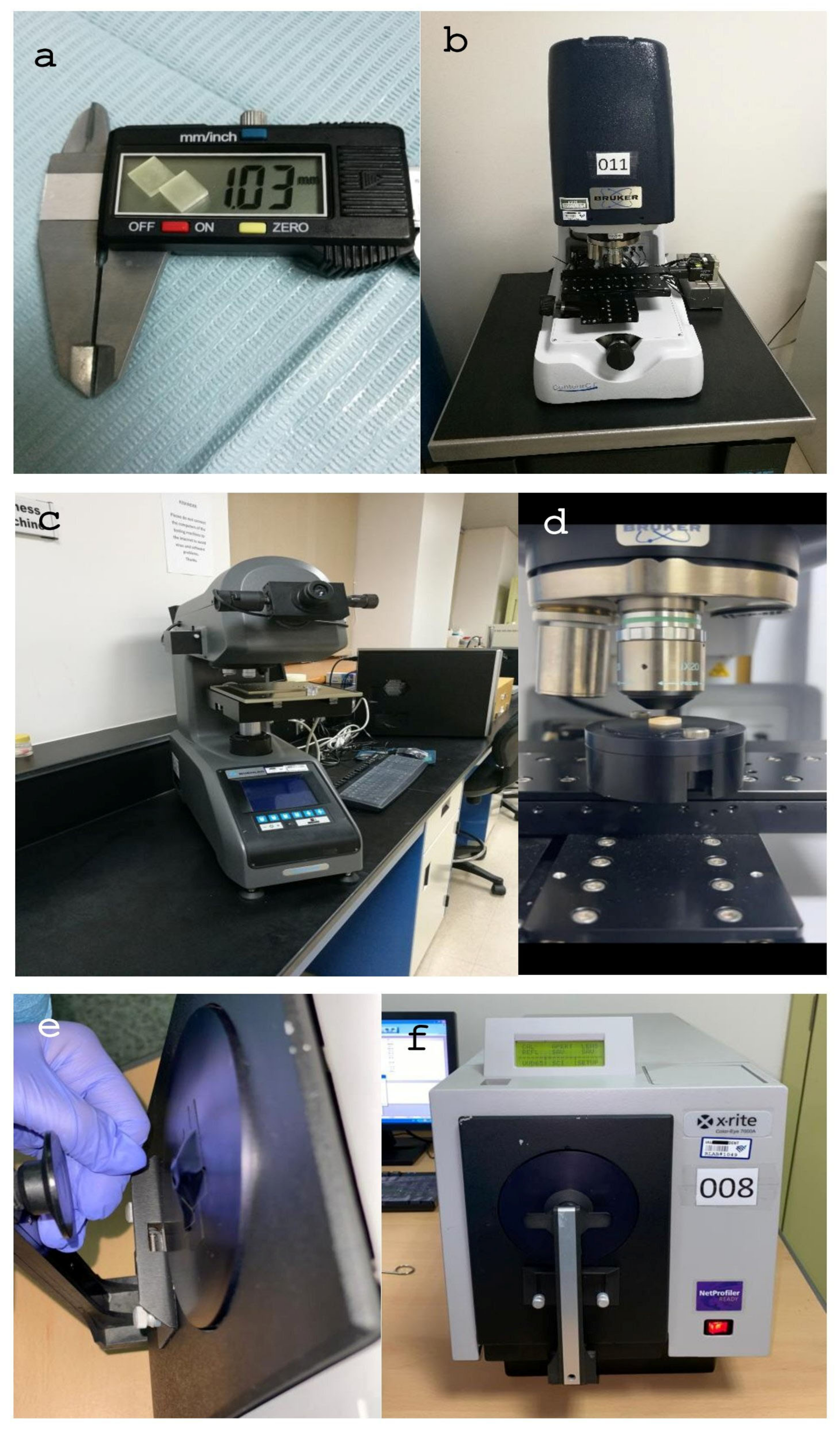



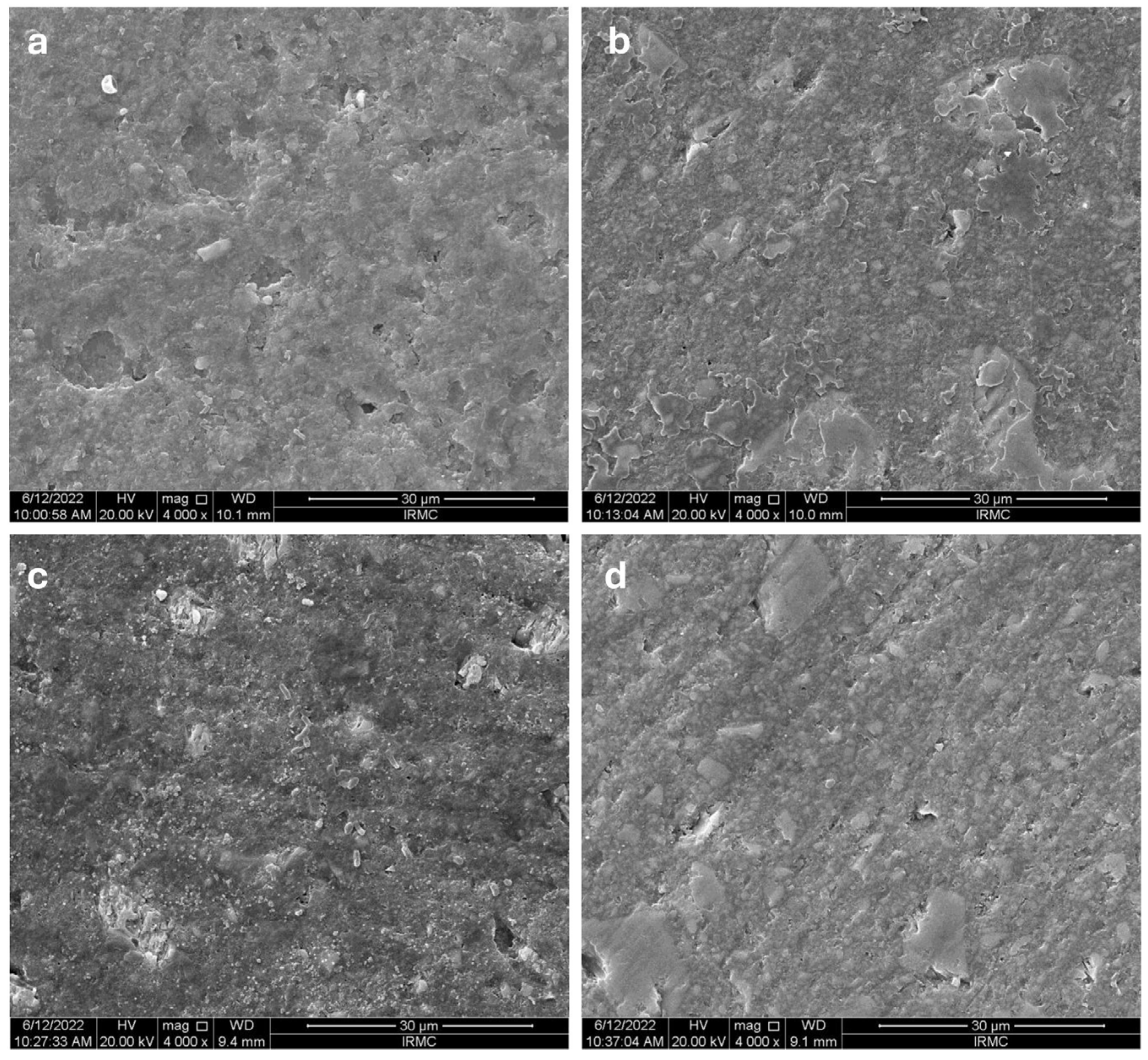
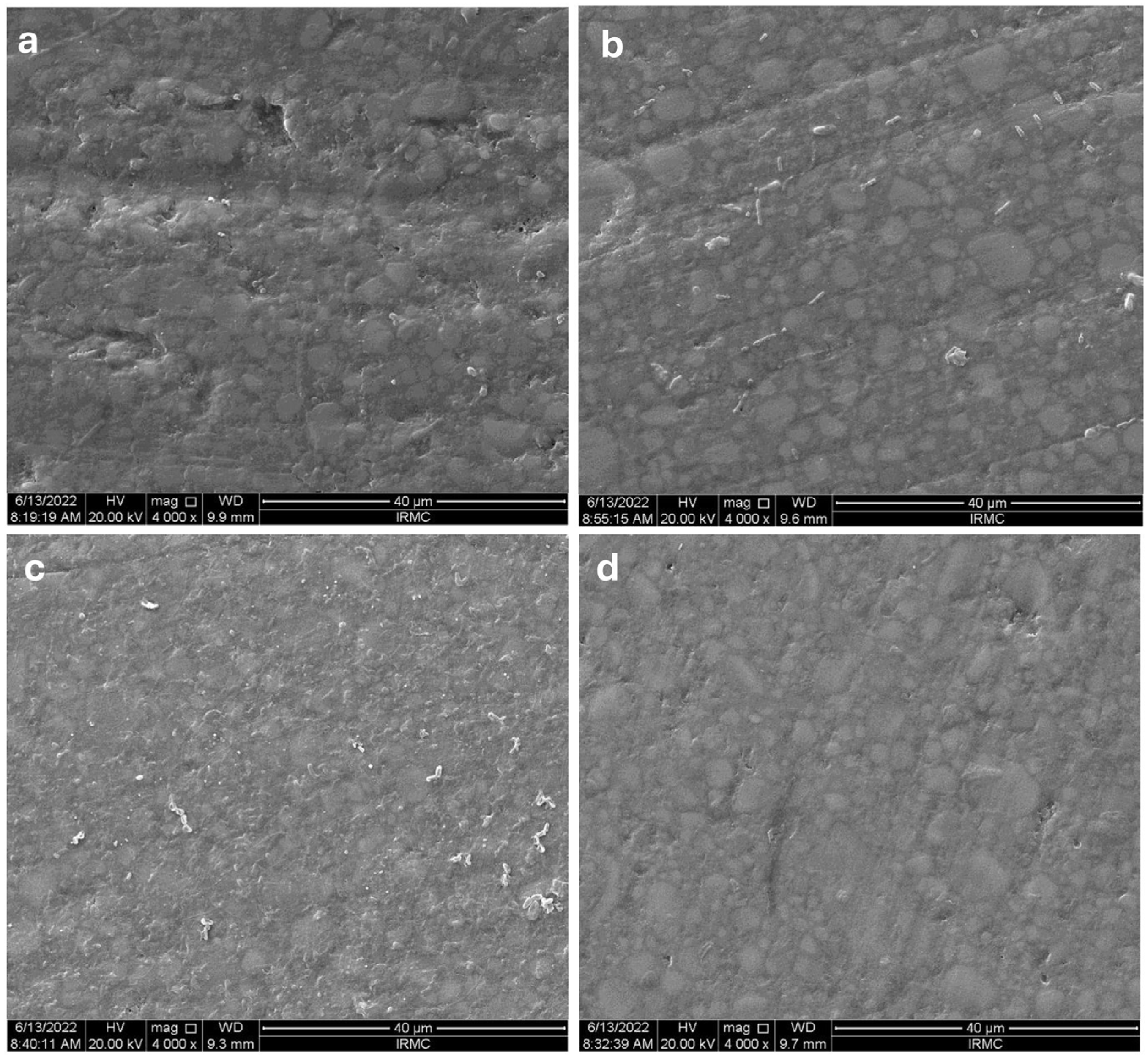
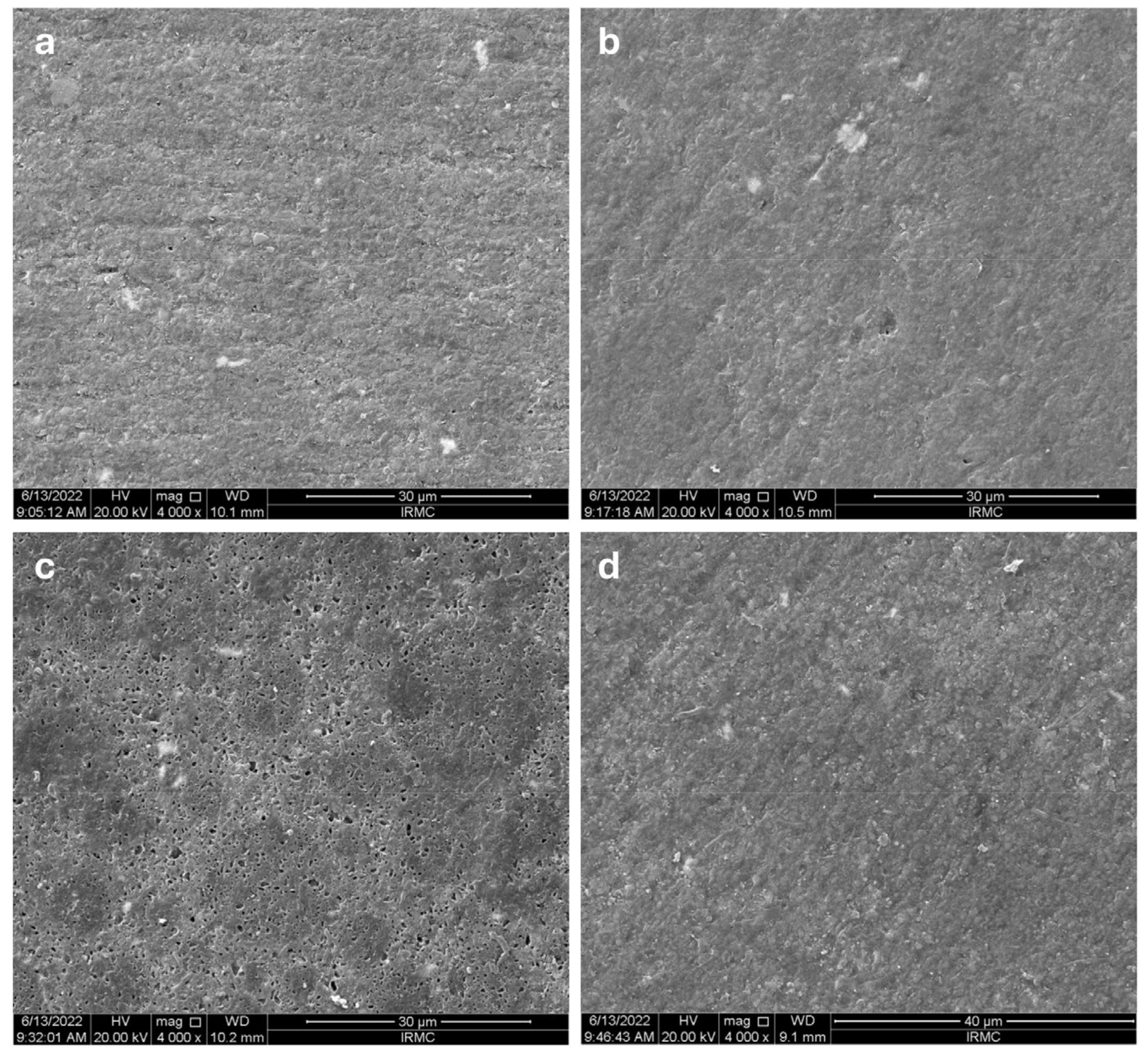
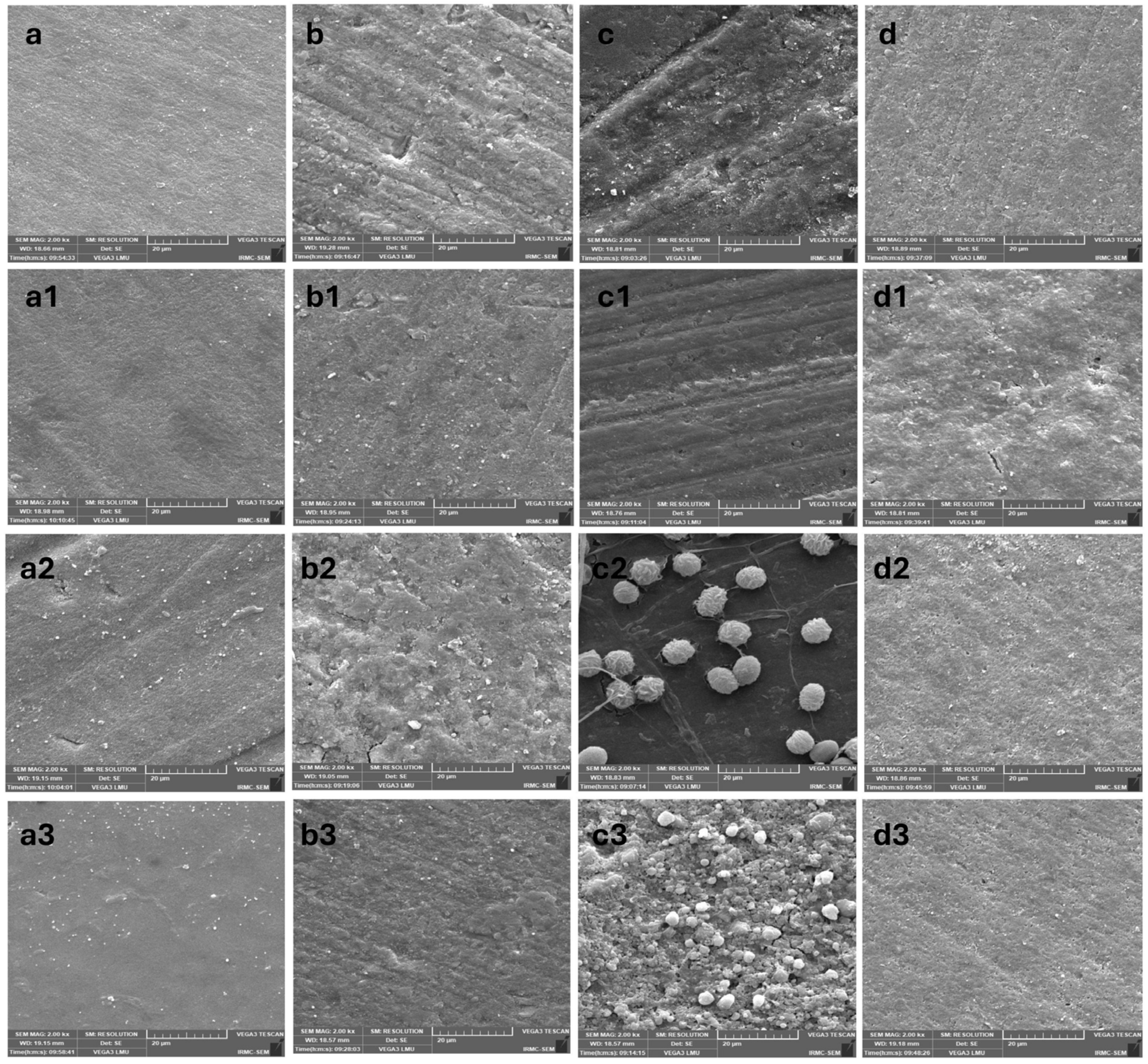
| Group | Solution | MH Baseline | MH Staining | MH Bleaching | |
|---|---|---|---|---|---|
| Mean ± SD | Mean ± SD | Mean ± SD | Sig. | ||
| Omnichroma | Coffee | 125.76 ± 2.93 | 138.60 a ± 11.37 | 122.78 ± 8.04 | 0.039 |
| RW | 130.22 ± 11.55 | 118.48 ± 14.72 | 113.31 ± 5.05 | 0.174 | |
| Soda | 136.70 ± 18.97 | 136.11 ± 11.20 | 116.88 a ± 5.18 | 0.174 | |
| D/W | 130.95 ± 9.69 | 132.25 ± 9.90 | 124.76 ± 38.95 | 0.368 | |
| Charisma | Coffee | 168.88 ± 17.36 | 178.15 a ± 18.76 | 162.41 ± 6.29 | 0.174 |
| RW | 154.76 ± 9.91 | 170.29 ± 12.40 | 143.35 ± 17.42 | 0.368 | |
| Soda | 157.92 ± 14.15 | 154.26 ± 8.77 | 144.27 ± 23.99 | 0.779 | |
| D/W | 178.23 ± 23.52 | 169.14 ± 14.04 | 168.83 ± 17.93 | 0.368 | |
| Z350 | Coffee | 191.92 ± 16.84 | 197.73 ± 26.90 | 166.28 ± 5.93 | 0.174 |
| RW | 187.27 ± 43.13 | 215.90 ± 30.92 | 151.78 a ± 49.60 | 0.018 | |
| Soda | 204.86 ± 30.75 | 198.65 ± 11.36 | 173.91 a ± 15.16 | 0.018 | |
| D/W | 204.61 ± 5.88 | 201.61 ± 9.72 | 167.12 a ± 21.17 | 0.039 | |
| TPH | Coffee | 139.98 ± 8.00 | 155.22 ± 24.21 | 133.31 ± 16.38 | 0.472 |
| RW | 156.54 ± 22.41 | 130.18 ± 17.27 | 106.76 a ± 23.73 | 0.039 | |
| Soda | 151.00 ± 8.60 | 138.70 a ± 19.87 | 123.47 a ± 22.01 | 0.018 | |
| D/W | 185.80 ± 48.97 | 136.19 ± 4.73 | 131.39 a ± 8.61 | 0.039 |
| Group | Solution | Ra Baseline | Ra Staining | Ra Bleaching | |
|---|---|---|---|---|---|
| Mean ± SD | Mean ± SD | Mean ± SD | Sig. | ||
| Omnichroma | Coffee | 520.69 ± 144.06 | 528.11 ± 159.95 | 623.18 ± 307.34 | 0.779 |
| RW | 934.49 ± 350.18 | 764.48 ± 481.00 | 957.94 ± 287.88 | 0.472 | |
| Soda | 813.59 ± 268.04 | 1009.36 ± 156.47 | 1005.71 ± 228.45 | 0.472 | |
| D/W | 1092.73 ± 538.84 | 898.08 ± 301.11 | 1018.17 ± 476.14 | 1.000 | |
| Charisma | Coffee | 637.96 ± 333.83 | 848.31 ± 213.39 | 893.12 ± 474.82 | 0.174 |
| RW | 516.56 ± 75.28 | 459.37 a ± 65.73 | 674.19 ± 115.40 | 0.018 | |
| Soda | 511.25 ± 42.31 | 519.01 ± 75.53 | 750.65 ± 457.18 | 0.779 | |
| D/W | 450.63 ± 122.72 | 466.04 ± 85.30 | 495.29 ± 108.64 | 1.000 | |
| Z350 | Coffee | 635.84 ± 113.88 | 774.94 ± 190.35 | 846.72 ± 156.77 | 0.105 |
| RW | 461.03 ± 99.19 | 460.24 ± 150.87 | 675.37 ± 130.66 | 0.039 | |
| Soda | 511.95 ± 114.33 | 622.84 ± 108.72 | 612.57 ± 364.19 | 0.779 | |
| D/W | 852.62 ± 428.87 | 583.49 ± 268.53 | 732.89 ± 281.99 | 0.050 | |
| TPH | Coffee | 540.75 ± 155.56 | 593.43 ± 149.63 | 502.41 a ± 93.81 | 0.105 |
| RW | 532.60 ± 127.56 | 581.88 ± 143.38 | 679.53 a ± 46.51 | 0.174 | |
| Soda | 500.47 ± 121.75 | 651.76 ± 34.97 | 921.67 a ± 439.97 | 0.174 | |
| D/W | 452.77 ± 97.44 | 428.08 ± 57.99 | 131.39 a ± 8.61 | 0.039 |
| Group | Solution | ΔE Baseline | ΔE Staining | ΔE Bleaching | |
|---|---|---|---|---|---|
| Mean ± SD | Mean ± SD | Mean ± SD | Sig. | ||
| Omnichroma | Coffee | 61.09 ± 2.75 | 60.99 ± 3.07 | 62.80 a ± 3.02 | 0.018 |
| RW | 61.50 ± 2.58 | 57.15 a,b ± 1.92 | 64.53 a ± 3.64 | 0.027 | |
| Soda | 63.25 ± 2.76 | 64.14 ± 4.13 | 64.32 ± 2.73 | 0.018 | |
| D/W | 63.60 ± 2.54 | 65.79 ± 2.91 | 64.46 ± 2.20 | 0.061 | |
| Charisma | Coffee | 57.52 ± 4.34 | 54.15 ± 1.12 | 60.16 ± 2.99 | 0.001 |
| RW | 58.11 ± 3.47 | 51.38 a ± 2.70 | 61.79 ± 3.82 | 0.002 | |
| Soda | 63.37 ± 5.15 | 63.88 ± 4.04 | 68.70 ± 5.06 | 0.001 | |
| D/W | 69.56 a ± 2.32 | 59.58 ± 2.00 | 61.44 ± 2.31 | 0.011 | |
| Z350 | Coffee | 72.54 ± 2.01 | 60.19 a ± 3.19 | 63.04 a,b ± 4.10 | 0.000 |
| RW | 73.43 a ± 1.16 | 60.19 a ± 1.37 | 67.19 ± 2.42 | 0.001 | |
| Soda | 69.06 ± 2.52 | 67.35 ± 1.31 | 67.75 ± 3.17 | 0.000 | |
| D/W | 69.49 ± 3.03 | 67.87 ± 2.10 | 71.29 ± 2.23 | 0.007 | |
| TPH | Coffee | 66.02 ± 1.92 | 59.41 a ± 1.66 | 66.55 a ± 2.53 | 0.000 |
| RW | 66.22 ± 2.15 | 61.04 ± 1.62 | 65.71 ± 2.54 | 0.000 | |
| Soda | 67.78 ± 2.25 | 68.39 ± 1.22 | 71.14 ± 2.06 | 0.000 | |
| D/W | 66.71 ± 1.30 | 67.61 ± 2.37 | 66.87 ± 1.37 | 0.001 |
Disclaimer/Publisher’s Note: The statements, opinions and data contained in all publications are solely those of the individual author(s) and contributor(s) and not of MDPI and/or the editor(s). MDPI and/or the editor(s) disclaim responsibility for any injury to people or property resulting from any ideas, methods, instructions or products referred to in the content. |
© 2025 by the authors. Licensee MDPI, Basel, Switzerland. This article is an open access article distributed under the terms and conditions of the Creative Commons Attribution (CC BY) license (https://creativecommons.org/licenses/by/4.0/).
Share and Cite
Ahmed, S.Z.; Al-Qahtani, S.; Al-Qahtani, N.H.; Al-Mulhim, H.; Al-Qahtani, M.; Albalushi, A.; Akhtar, S. Degradation Resistance of Next-Generation Dental Composites Under Bleaching and Immersion: A Multiscale Investigation. Prosthesis 2025, 7, 57. https://doi.org/10.3390/prosthesis7030057
Ahmed SZ, Al-Qahtani S, Al-Qahtani NH, Al-Mulhim H, Al-Qahtani M, Albalushi A, Akhtar S. Degradation Resistance of Next-Generation Dental Composites Under Bleaching and Immersion: A Multiscale Investigation. Prosthesis. 2025; 7(3):57. https://doi.org/10.3390/prosthesis7030057
Chicago/Turabian StyleAhmed, Syed Zubairuddin, Shahad Al-Qahtani, Naif H. Al-Qahtani, Hussah Al-Mulhim, Maha Al-Qahtani, Ali Albalushi, and Sultan Akhtar. 2025. "Degradation Resistance of Next-Generation Dental Composites Under Bleaching and Immersion: A Multiscale Investigation" Prosthesis 7, no. 3: 57. https://doi.org/10.3390/prosthesis7030057
APA StyleAhmed, S. Z., Al-Qahtani, S., Al-Qahtani, N. H., Al-Mulhim, H., Al-Qahtani, M., Albalushi, A., & Akhtar, S. (2025). Degradation Resistance of Next-Generation Dental Composites Under Bleaching and Immersion: A Multiscale Investigation. Prosthesis, 7(3), 57. https://doi.org/10.3390/prosthesis7030057








